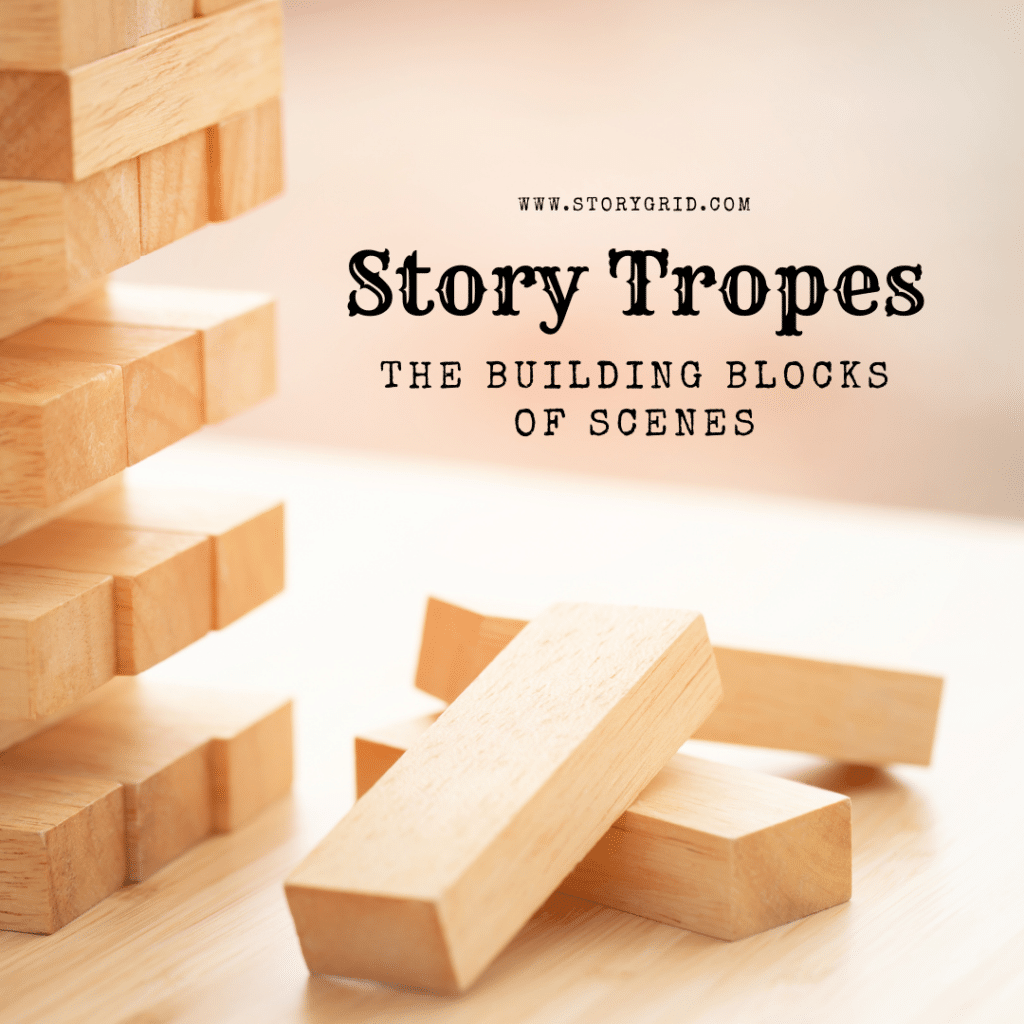What is a Trope?
Tropes are a toolbox of common components to build a certain kind of story. You can put these building blocks together to create a story that meets the reader expectations for your particular GENRE.
Most lists of tropes are a grab bag of story types and/or their components and aspects. They don’t fit together, so they don’t provide a process for consistently crafting scenes and stories that satisfy readers.
In the Story Grid Universe, we provide this process by limiting the definition of a trope to a particular level of Story. Story Grid tropes are small STORY UNITS that are the building blocks writers need to create the arc of change within SCENES.

What’s the Structure, Function, and Organization of Book Tropes?
To understand how tropes can help writers, we need to explore the relationship between their whole structure, their function, and the organization of their parts.
Trope Structure
Tropes are the building blocks of SCENES, and every part of a scene is part of a trope. To identify trope structure, we look at the generalized patterns of AVATAR behavior and divide them into graspable and portable units of conflict and change.
Trope Function
Story tropes engage the SINGLE AUDIENCE MEMBER of the NARRATIVE PATH and generate progressively escalating excitement and anxiety.
The progression of tropes demonstrates character. The Avatar-Protagonist pursues micro strategies to reach their scene-level goals. They do so in a particular order that shows how they prioritize the risks involved with the course of action. Each micro strategy is a trope.
As the initial strategy fails trope by trope, the Avatar-Protagonist’s choices change the global value and advance the plot. Employing effective story tropes helps maintain consistency in Avatars’ behavior, which connects them to their global archetypical roles.
Trope Organization
Tropes are made up of a series of BEATS that progress toward the disintegration of consistent micro strategies the AVATARS employ to pursue their goals.
What are the key features of Book Tropes?
- Goals. AVATARS pursue the micro strategies within tropes to pursue their scene-level goals.
- Activities. AVATARS engage in consistent micro strategies according to the context and the generalizable pattern of interaction in the trope.
- Stakes. Tropes demonstrate the relative risk as AVATARS prioritize certain micro strategies over others.
- Graspable. Tropes are comprehensible and identifiable patterns of micro strategies that AVATARS engage in to pursue what they want.
- Portable. Because they are generalized patterns of behavior, tropes can be used in different types of scenes and within the scenes of different CONTENT GENRES.
What are the benefits of using Tropes in writing stories?
- Tropes are the UNIT OF STORY that bridges Story Event, FIVE COMMANDMENTS OF STORYTELLING, and line-by-line writing within scenes.
- Progressive complication tropes typically introduce the stakes for the SCENE-level CRISIS.
- Tropes enable writers to communicate the STORY EVENT or the mini-controlling idea of the scene to readers.
- Writers can learn to identify tropes in great examples of stories, what we call MASTERWORKS. Once writers can spot these building blocks in a Masterwork scene, they can add specificity according to the CONTENT GENRE and the relevant details of their own stories.
- Tropes are recognizable patterns of behavior and conflict that readers notice subconsciously. The effective use of tropes allows writers to craft scenes that feel real.
What are some recognizable Tropes?
An exhaustive list would be too lengthy to include in this article, but here are a few tropes writers can use in almost any story.
- Setting the scene. Writers use this trope to set up the context and content of the scene. This Trope introduces the scope and stakes of the scene, among other details.
- Goliath approaches. A powerful antagonist advances on the relatively disadvantaged protagonist. Although this suggests an attack, it could be the approach of a Shadow Mentor in a PERFORMANCE Story or a Harmer in a LOVE Story.
- The rival raises the stakes. Once protagonist and rival are engaged in conflict, the rival increases the risk to the protagonist while also making it harder to exit without negative consequences.
- Interviewer interrogates interviewee. An interviewer directly challenges the interviewee to test their resolve. The interviewee can comply or defy.
- Mouse luring the cat into a trap. The protagonist outwits the antagonist through distraction and sets a trap to expose the antagonist’s weakness.
How to begin to identify Book Tropes within masterwork or pattern scene text?
It takes time and deliberate practice to use tropes to plan, draft, and revise scenes, but writers can begin by studying scenes in MASTERWORKS. They can look for AVATARS embodying consistent archetypal roles (e.g., mentor and mentee; interviewer and interviewee; or victim, savior, and persecutor) and micro strategies (e.g., praising, challenging, obscuring) in MASTERWORK SCENES.
Additional Trope Resources
Join the Story Grid Guild! Story Grid Guild members gain access to training in Scene writing, including planning scene tropes and constructing BEATS.